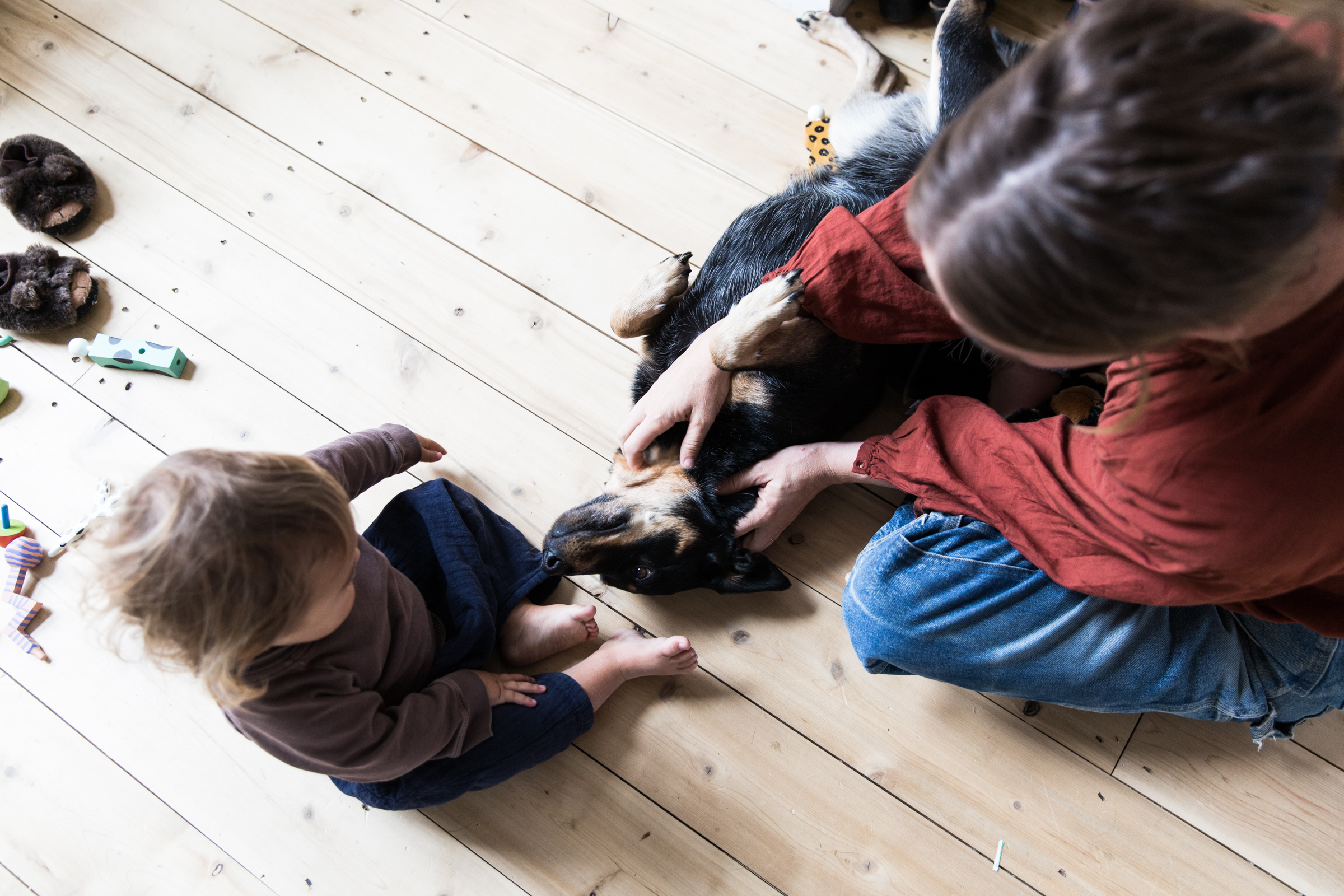
Toddlers & Dogs: How To Keep ‘Em Safe From Each Other
Written by Jessica Williams
Photography by Julie O'Rourke, photographed by Greta Rybus
Toddlers can be so cute. And toddlers playing with the family dog can be even cuter. That is, until they try pulling Spot’s tail or giving him a squeeze. We’ve written about introducing your baby to your dog, but what happens when that baby becomes a toddler, someone who would love nothing more than to grab that really fun, fluffy, wagging tail? While keeping a toddler from innocently terrorizing the family terrier can drive any mama crazy, we’ve rounded up some helpful—and ultimately very important—tips on keeping the pup safe from the toddler, and vice versa.
Provide a Safe Space. Your dog and your child each need a safe space, says Dr. Jeannine Berger, Vice President of Rescue and Welfare at the San Francisco SPCA, one of the oldest U.S. humane societies. “The dog needs to have a safe space where it predictably can retreat if he’s had enough. And there should also be a space for the kid.” To explain, your toddler should have a safe space to play energetically, and the dog should have the choice not to have to be there. A comfortable spot such as a mat or crate can provide a safe space for your dog. The American Veterinary Medical Association recommends teaching children the dog should not be bothered if in his safe space: “Teach children that if a dog goes to bed or to his/her crate, don’t bother them. Enforce the idea that the bed or crate is the dog’s space to be left alone. A dog needs a comfortable, safe place where the child never goes.”
Encourage Predictable Positive Interaction. Your child should be involved in all the fun stuff that’s happening, says Berger. When your toddler is reliably involved in positive interactions, like giving the dog a toy or treat or walk, the dog associates that positive interaction with your toddler. Your dog comes to understand that when the child is around, good stuff flies his way, says Berger, and you foster a good relationship between dog and child simply by classical conditioning. Some dogs hide their treats & toys from children to keep it safe and secure.
Always, Always Supervise Interactions Between Your Toddler and Dog. According to the American Veterinary Medical Association, children are, by far, the most common victims of dog bites. They are also far more likely to suffer severe injuries. In fact, each year, about 400,000 U.S. kids receive medical attention for dog bites, which most often occur during everyday activities and while interacting with familiar dogs. Stories of what can quickly go wrong during unsupervised interactions are harrowing. “I have examples of 2-year-olds getting bitten in the face, and no one in the family saw it,” says Berger. “I think that oftentimes parents have a false expectation of what should be tolerated from the dog’s end because we all have a story of a dog that does tolerate that. But oftentimes that can later lead to problems when the dog either gets older or if the dog has just had enough, and [the child’s behavior] pushes the dog over the threshold.” Books like Tails Are Not For Pulling, written by Elizabeth Verdick and illustrated by Marieka Heinlen, can help teach your toddler how to interact gently with the family dog.
Watch Your Dog’s Body Language for Subtle Signs of Stress. Before a growl, which is a pretty serious sign your dog is not comfortable, may come other, more subtle signs of fear, anxiety, and stress. These include gaze aversion (turning the head or body away), yawning, lid blinking, and other signs, such as those illustrated in (free, downloadable) posters by Dr. Sophia Yin, veterinarian and animal behaviorist. “Gaze aversion is the very first sign of disengagement,” says Berger, explaining that a growl is really a scream for help from a dog’s perspective.
If Choosing a New Dog For Your Family, Look at the Individual. The American Kennel Club provides a list of the best dog breeds for kids, but Berger cautions against merely looking at breeds when choosing a dog since even dogs of the same breed can be very different. Plus, if adopting from a shelter, you’ll find most dogs are mixed breeds. “Look at the individual you’re getting. Is that a suitable dog?” suggests Berger, noting that some questions to consider are whether the dog is comfortable with handling, with people coming to the house, with being touched suddenly, or with noises. Also consider whether the dog has been properly socialized and whether the dog’s size fits with the family. “Sometimes a big, energetic dog may be too much for young children,” says Berger. If adopting from a shelter, get as much information about the dog as possible and assume the dog had limited or no interaction with kids. “It’s definitely important to learn where the dog comes from, early socialization, and any findings they had while interacting with the dog,” says Berger. “I would start out assuming the dog had no or limited interactions with kids, so start building that relationship gradually and slowly so the dog does not get overwhelmed.” Also be sure to adopt from a reputable organization that will take the dog back if the family environment is not a good fit.
Regarding Unfamiliar Dogs, Always Ask Permission to Pet. Teach your toddler how to properly interact with an unfamiliar dog, like one at the park or at a friend’s house. “Never, ever let your child touch an unfamiliar dog without asking permission from the owner first,” advises Berger. Also, be willing to accept that some owners may not want their dog to be touched as not all dogs are used to kids or fond of kids. It’s also good to ask the dog for a command, like “sit” or “shake” or “lie down,” rather than simply reaching out to pet the dog. May I Pet Your Dog?, written by Stephanie Calmenson and illustrated by Jan Ormerod, can help teach your toddler the cardinal-rule of interacting with unfamiliar dogs: ask permission first.
Comments are closed.
Share this story





Since i was a child, my family always had a dog at home. But, luckily we never had problems with it, and i think we always have to take care. Your tips are awesome, thanks